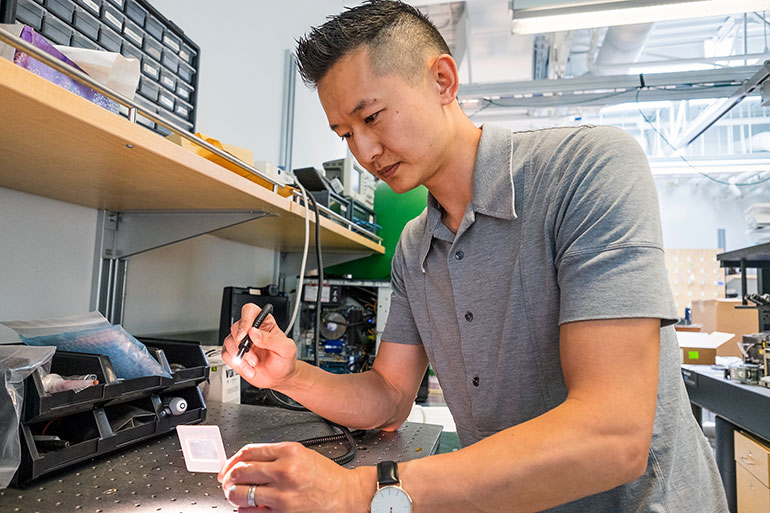
Kenneth Chau, associate professor of engineering at UBC Okanagan.
Discovery by international research team advances understanding of light momentum
The idea that light has momentum is not new, but the exact nature of how light interacts with matter has remained a mystery for close to 150 years. New research from UBC’s Okanagan campus, recently published in Nature Communications, may have uncovered the keys to one of the darkest secrets of light.
Johannes Kepler, famed German astronomer and mathematician, first suggested in 1619 that pressure from sunlight could be responsible for a comet’s tail always pointing away from the Sun, says study co-author and UBC Okanagan Engineering Professor Kenneth Chau. It wasn’t until 1873 that James Clerk Maxwell predicted that this radiation pressure was due to the momentum residing within the electromagnetic fields of light itself.
“Until now, we hadn’t determined how this momentum is converted into force or movement,” says Chau. “Because the amount of momentum carried by light is very small, we haven’t had equipment sensitive enough to solve this.”
Now that technology is sensitive enough, Chau, with his international research team from Slovenia and Brazil, are shedding light on this mystery.
To measure these extremely weak interactions between light photons, the team constructed a special mirror fitted with acoustic sensors and heat shielding to keep interference and background noise to a minimum. They then shot laser pulses at the mirror and used the sound sensors to detect elastic waves as they moved across the surface of the mirror, like watching ripples on a pond.
“We can’t directly measure photon momentum, so our approach was to detect its effect on a mirror by ‘listening’ to the elastic waves that traveled through it,” says Chau. “We were able to trace the features of those waves back to the momentum residing in the light pulse itself, which opens the door to finally defining and modelling how light momentum exists inside materials.”
The discovery is important in advancing our fundamental understanding of light, but Chau also points to practical applications of radiation pressure.
“Imagine travelling to distant stars on interstellar yachts powered by solar sails,” says Chau. “Or perhaps, here on Earth, developing optical tweezers that could assemble microscopic machines.”
“We’re not there yet, but the discovery in this work is an important step and I’m excited to see where it takes us next.”
The study was published on August 21 in Nature Communications with funding from the Natural Sciences and Engineering Research Council of Canada, the Slovenian Research Agency, CAPES, CNPq and Fundação Araucária.
About UBC's Okanagan campus
UBC’s Okanagan campus is an innovative hub for research and learning in the heart of British Columbia’s stunning Okanagan Valley. Ranked among the top 20 public universities in the world, UBC is home to bold thinking and discoveries that make a difference. Established in 2005, the Okanagan campus combines a globally recognized UBC education with a tight-knit and entrepreneurial community that welcomes students and faculty from around the world. For more visit ok.ubc.ca.
 Oil company fined
Oil company fined Strata smoking fines tossed
Strata smoking fines tossed Seeking a wildfire 'hero'
Seeking a wildfire 'hero' UN workers charged
UN workers charged  Trudeau in Saskatoon
Trudeau in Saskatoon  Doctors protest tax change
Doctors protest tax change $620 million for Ukraine
$620 million for Ukraine  5 die crossing channel
5 die crossing channel Jury finds railway at fault
Jury finds railway at fault  Tourism operators struggle
Tourism operators struggle  Nude Beverages sells line
Nude Beverages sells line Wealth gap widening
Wealth gap widening Leafs even series
Leafs even series Cristall gets pro look
Cristall gets pro look Warriors even series in OT
Warriors even series in OT Hozier surprised by #1
Hozier surprised by #1 Trainor to replace Perry?
Trainor to replace Perry? Swift breaks Spotify record
Swift breaks Spotify record


